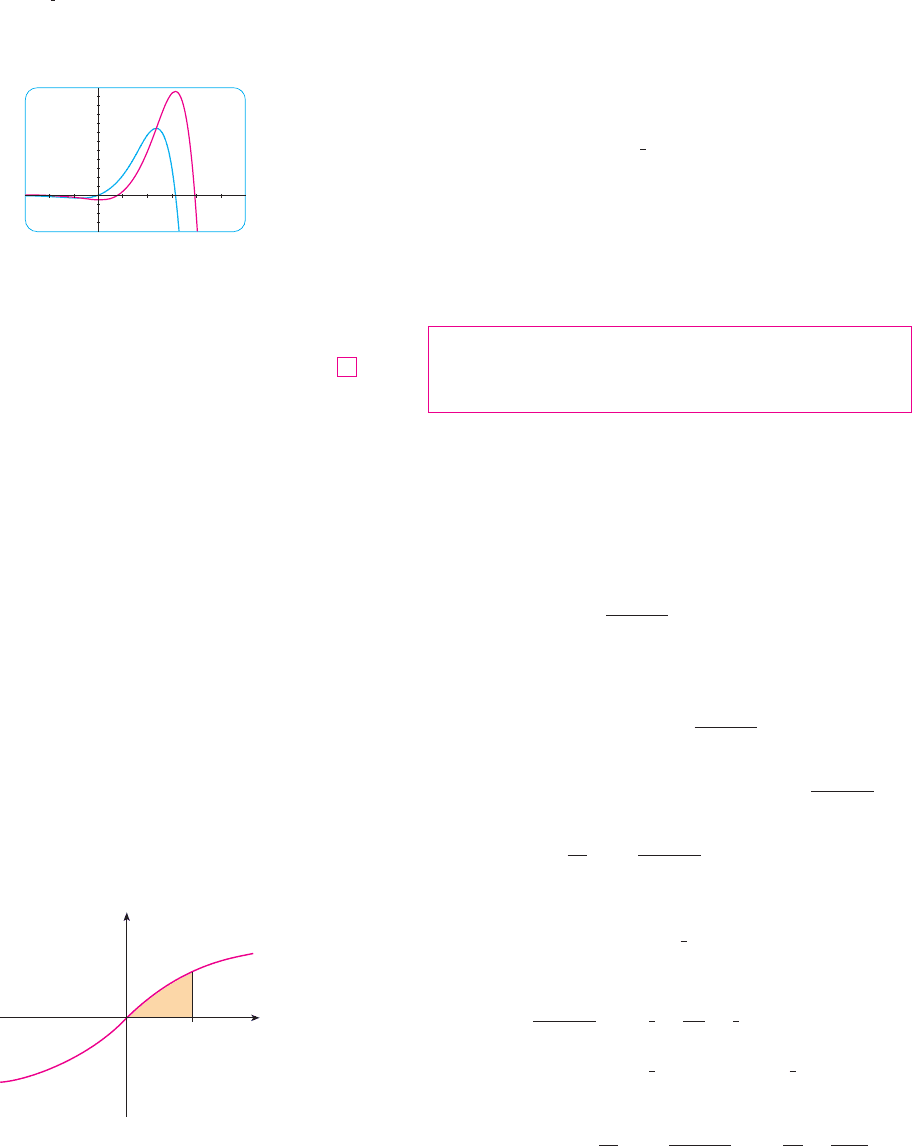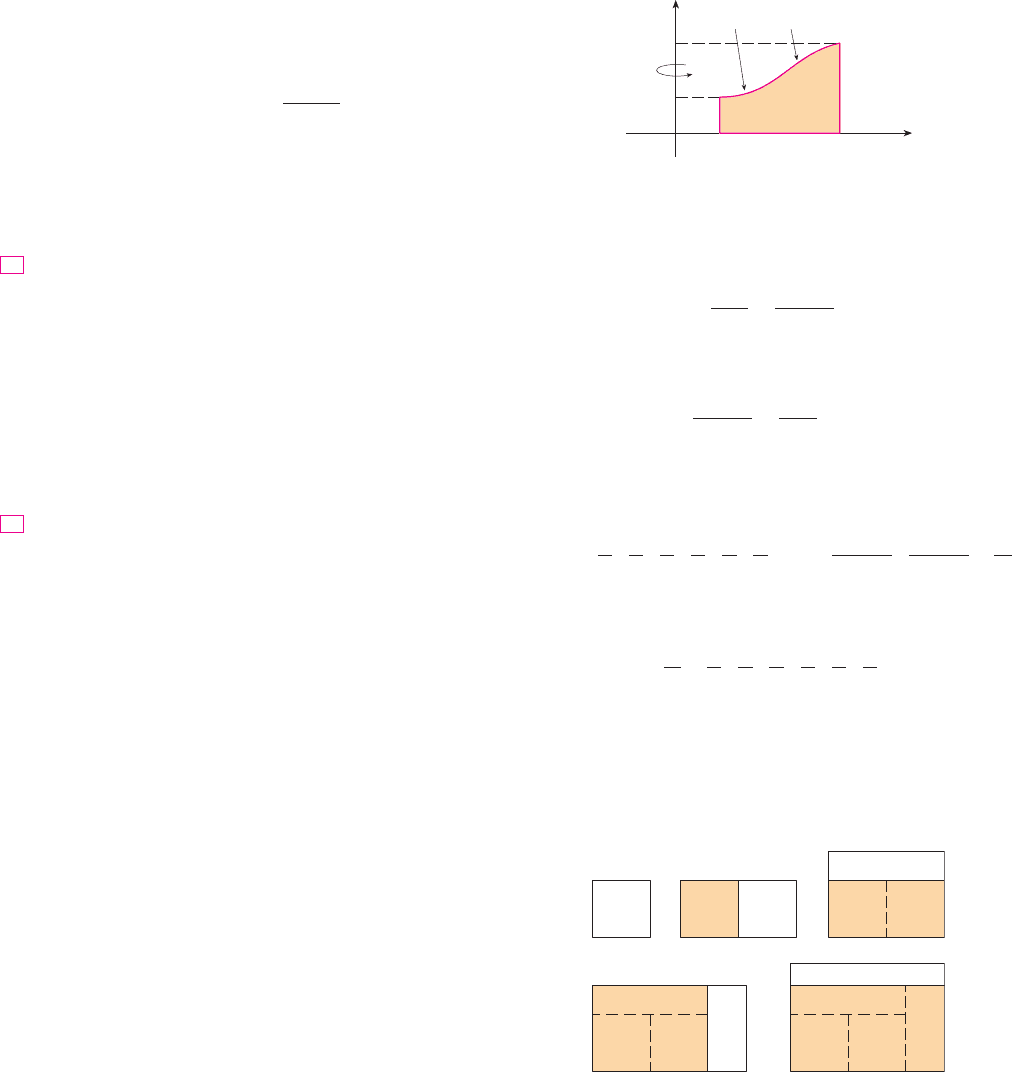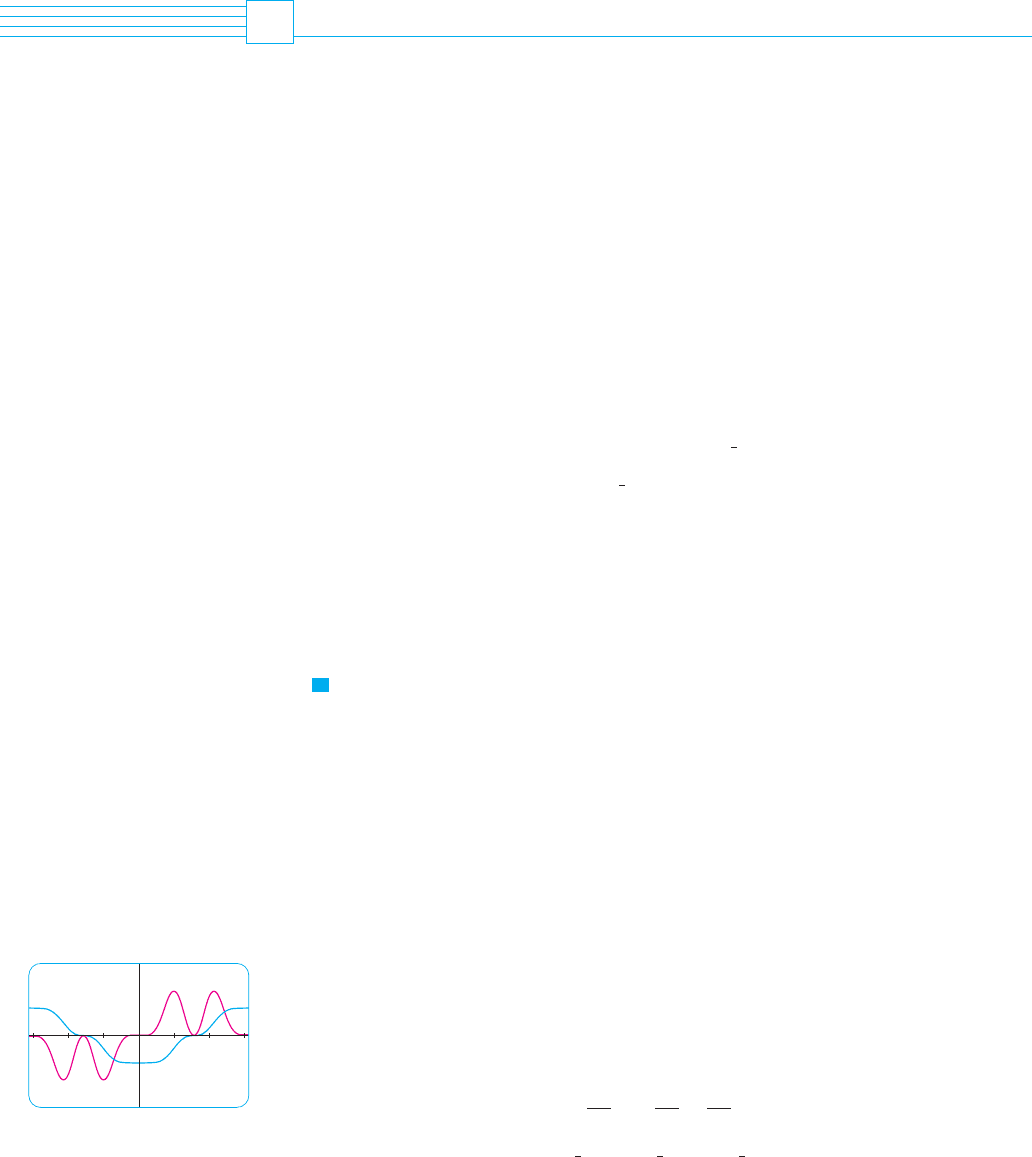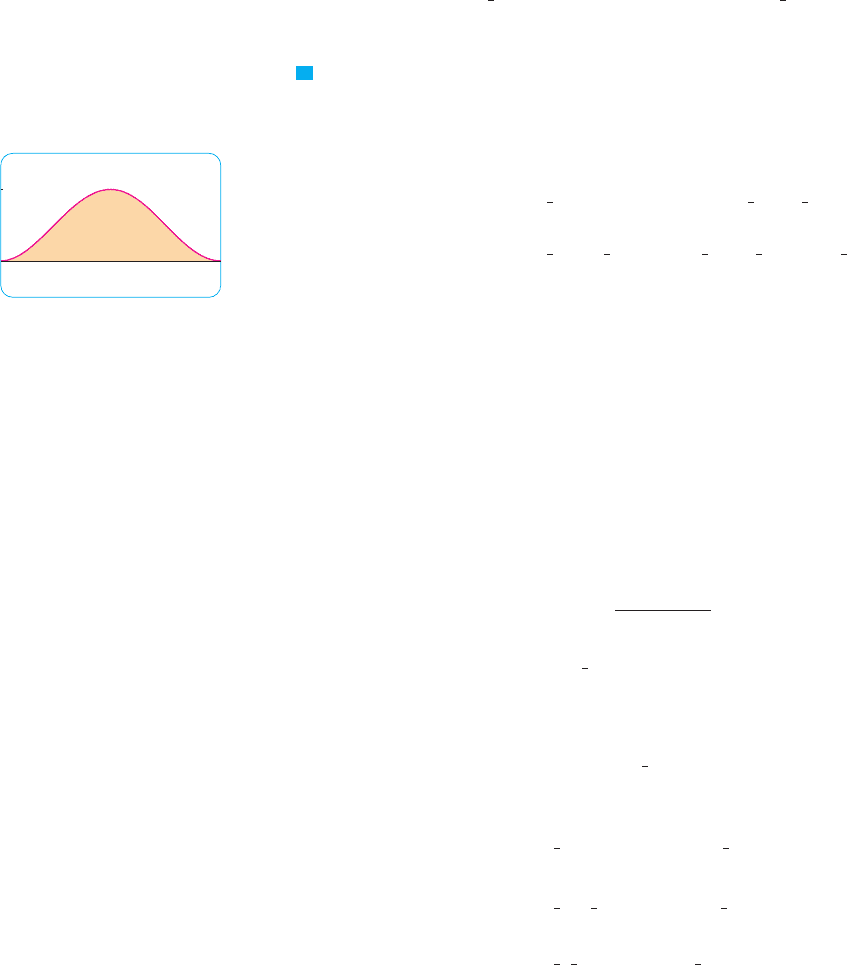Stewart J. Calculus
Подождите немного. Документ загружается.


This can be regarded as an equation to be solved for the unknown integral. Adding
to both sides, we obtain
Dividing by 2 and adding the constant of integration, we get
M
If we combine the formula for integration by parts with Part 2 of the Fundamental
Theorem of Calculus, we can evaluate definite integrals by parts. Evaluating both sides of
Formula 1 between and , assuming and are continuous, and using the Fundamental
Theorem, we obtain
EXAMPLE 5 Calculate .
SOLUTION Let
Then
So Formula 6 gives
To evaluate this integral we use the substitution (since has another meaning
in this example). Then , so . When , ; when ,
; so
Therefore
M
y
1
0
tan
!1
x dx !
$
4
!
y
1
0
x
1 " x
2
dx !
$
4
!
ln 2
2
!
1
2
$ln 2 ! ln 1% !
1
2
ln 2
y
1
0
x
1 " x
2
dx !
1
2
y
2
1
dt
t
!
1
2
ln
#
t
#
]
1
2
t ! 2
x ! 1t ! 1x ! 0x dx !
1
2
dtdt ! 2x dx
ut ! 1 " x
2
!
$
4
!
y
1
0
x
1 " x
2
dx
! 1 ! tan
!1
1 ! 0 ! tan
!1
0 !
y
1
0
x
1 " x
2
dx
y
1
0
tan
!1
x dx ! x tan
!1
x
]
0
1
!
y
1
0
x
1 " x
2
dx
du !
dx
1 " x
2
v ! x
u ! tan
!1
x dv ! dx
y
1
0
tan
!1
x dx
y
b
a
f $x%t#$x% dx ! f $x%t$x%
]
a
b
!
y
b
a
t$x%f #$x% dx
6
t#f #ba
y
e
x
sin x dx !
1
2
e
x
$sin x ! cos x% " C
2
y
e
x
sin x dx ! !e
x
cos x " e
x
sin x
x e
x
sin x dx
492
|| ||
CHAPTER 8 TECHNIQUES OF INTEGRATION
N Since for , the integral in
Example 5 can be interpreted as the area of the
region shown in Figure 2.
x % 0tan
!1
x % 0
y
0
x
1
y=tan–!x
F I G U R E 2
N Figure 1 illustrates Example 4 by show-
ing the graphs of and
. As a visual check
on our work, notice that when has
a maximum or minimum.
Ff $x% ! 0
F$x% !
1
2
e
x
$sin x ! cos x%
f $x% ! e
x
sin x
_3
_4
12
6
F
f
F I G U R E 1

EXAMPLE 6 Prove the reduction formula
where is an integer.
SOLUTION Let
Then
so integration by parts gives
Since , we have
As in Example 4, we solve this equation for the desired integral by taking the last term
on the right side to the left side. Thus we have
or
M
The reduction formula (7) is useful because by using it repeatedly we could eventually
express in terms of (if is odd) or (if is even).n
x $sin x%
0
dx ! x dxnx sin x dxx sin
n
x dx
y
sin
n
x dx ! !
1
n
cos x sin
n!1
x "
n ! 1
n
y
sin
n!2
x dx
n
y
sin
n
x dx ! !cos x sin
n!1
x " $n ! 1%
y
sin
n!2
x dx
y
sin
n
x dx ! !cos x sin
n!1
x " $n ! 1%
y
sin
n!2
x dx ! $n ! 1%
y
sin
n
x dx
cos
2
x ! 1 ! sin
2
x
y
sin
n
x dx ! !cos x sin
n!1
x " $n ! 1%
y
sin
n!2
x cos
2
x dx
v ! !cos x du ! $n ! 1% sin
n!2
x cos x dx
dv ! sin x dx u ! sin
n!1
x
n % 2
y
sin
n
x dx ! !
1
n
cos x sin
n!1
x "
n ! 1
n
y
sin
n!2
x dx
7
SECTION 8.1 INTEGRATION BY PARTS
|| ||
493
N Equation 7 is called a
reduction formula
because the exponent has been
reduced
to
and .n ! 2n ! 1
n
11. 12.
13. 14.
16.
18.
19.
21. 22.
23. 24.
y
$
0
x
3
cos x dx
y
2
1
ln x
x
2
dx
y
9
4
ln y
s
y
dy
y
1
0
t cosh t dt
y
1
0
$x
2
" 1%e
!x
dx
20.
y
$
0
t sin 3t dt
y
e
!
&
cos 2
&
d
&
y
e
2
&
sin 3
&
d
&
17.
y
t sinh mt dt
y
$ln x%
2
dx
15.
y
s 2
s
ds
y
t sec
2
2t dt
y
p
5
ln p dp
y
arctan 4t dt
1–2 Evaluate the integral using integration by parts with the
indicated choices of and .
1. ; ,
2. ; ,
3–32 Evaluate the integral.
4.
5. 6.
7. 8.
9. 10.
y
sin
!1
x dx
y
ln$2x " 1% dx
y
x
2
cos mx dx
y
x
2
sin
$
x dx
y
t sin 2t dt
y
re
r(2
dr
y
xe
!x
dx
y
x cos 5x dx
3.
dv ! cos
&
d
&
u !
&
y
&
cos
&
d
&
dv ! x
2
dxu ! ln x
y
x
2
ln x dx
d
vu
E X E R C I S E S
8.1

(b) Use part (a) to evaluate and .
(c) Use part (a) to show that, for odd powers of sine,
46. Prove that, for even powers of sine,
47–50 Use integration by parts to prove the reduction formula.
48.
49.
50.
51. Use Exercise 47 to find .
52. Use Exercise 48 to find .
53–54 Find the area of the region bounded by the given curves.
53. , ,
54.
;
55–56 Use a graph to find approximate -coordinates of the
points of intersection of the given curves. Then find (approxi-
mately) the area of the region bounded by the curves.
55. ,
56. ,
57–60 Use the method of cylindrical shells to find the volume
generated by rotating the region bounded by the given curves
about the specified axis.
, , ; about the -axis
58. , , ; about the -axis
59. , , , ; about
60. , , ; about the -axisxy !
$
x ! 0y ! e
x
x ! 1x ! 0x ! !1y ! 0y ! e
!x
yx ! 1y ! e
!x
y ! e
x
y0 ' x ' 1y ! 0y ! cos$
$
x(2%
57.
y !
1
2
xy ! arctan 3x
y ! $x ! 2%
2
y ! x sin x
x
y ! x ln xy ! 5 ln x,
x ! 5y ! 0y ! xe
!0.4x
x x
4
e
x
dx
x $ln x%
3
dx
$n " 1%
y
sec
n
x dx !
tan x sec
n!2
x
n ! 1
"
n ! 2
n ! 1
y
sec
n!2
x dx
$n " 1%tan
n
x dx !
tan
n!1
x
n ! 1
!
y
tan
n!2
x dx
y
x
n
e
x
dx ! x
n
e
x
! n
y
x
n!1
e
x
dx
y
$ln x%
n
dx ! x $ln x%
n
! n
y
$ln x%
n!1
dx
47.
y
$
(2
0
sin
2n
x dx !
1 ! 3 ! 5 ! ( ( ( ! $2n ! 1%
2 ! 4 ! 6 ! ( ( ( ! 2n
$
2
y
$
(2
0
sin
2n"1
x dx !
2 ! 4 ! 6 ! ( ( ( ! 2n
3 ! 5 ! 7 ! ( ( ( ! $2n " 1%
x
$
(2
0
sin
5
x dxx
$
(2
0
sin
3
x dx
25. 26.
27. 28.
29. 30.
31. 32.
33 –38 First make a substitution and then use integration by parts
to evaluate the integral.
33. 34.
36.
37. 38.
;
39 – 42 Evaluate the indefinite integral. Illustrate, and check that
your answer is reasonable, by graphing both the function and its
antiderivative (take ).
39. 40.
41. 42.
43. (a) Use the reduction formula in Example 6 to show that
(b) Use part (a) and the reduction formula to evaluate
.
44. (a) Prove the reduction formula
(b) Use part (a) to evaluate .
(c) Use parts (a) and (b) to evaluate .
45. (a) Use the reduction formula in Example 6 to show that
where is an integer.n % 2
y
$
(2
0
sin
n
x dx !
n ! 1
n
y
$
(2
0
sin
n!2
x dx
x cos
4
x dx
x cos
2
x dx
y
cos
n
x dx !
1
n
cos
n!1
x sin x "
n ! 1
n
y
cos
n!2
x dx
x sin
4
x dx
y
sin
2
x dx !
x
2
!
sin 2x
4
" C
y
x
2
sin 2x dx
y
x
3
s
1 " x
2
dx
y
x
3(2
ln x dx
y
$2x " 3%e
x
dx
C ! 0
y
sin$ln x% dx
y
x ln$1 " x% dx
y
$
0
e
cos t
sin 2t dt
y
s
$
s
$
(2
&
3
cos$
&
2
% d
&
35.
y
t
3
e
!t
2
dt
y
cos
s
x
dx
y
t
0
e
s
sin$t ! s% ds
y
2
1
x
4
$ln x%
2
dx
y
1
0
r
3
s
4 " r
2
dr
y
cos x ln$sin x% dx
y
2
1
$ln x%
2
x
3
dx
y
1(2
0
cos
!1
x dx
y
s
3
1
arctan$1(x% dx
y
1
0
y
e
2y
dy
494
|| ||
CHAPTER 8 TECHNIQUES OF INTEGRATION

SECTION 8.1 INTEGRATION BY PARTS
|| ||
495
parts on the resulting integral to prove that
68. Let .
(a) Show that .
(b) Use Exercise 46 to show that
(c) Use parts (a) and (b) to show that
and deduce that .
(d) Use part (c) and Exercises 45 and 46 to show that
This formula is usually written as an infinite product:
and is called the Wallis product.
(e) We construct rectangles as follows. Start with a square of
area 1 and attach rectangles of area 1 alternately beside or
on top of the previous rectangle (see the figure). Find the
limit of the ratios of width to height of these rectangles.
$
2
!
2
1
!
2
3
!
4
3
!
4
5
!
6
5
!
6
7
! ( ( (
lim
n
l
)
2
1
!
2
3
!
4
3
!
4
5
!
6
5
!
6
7
! ( ( ( !
2n
2n ! 1
!
2n
2n " 1
!
$
2
lim
n
l
)
I
2n"1
(I
2n
! 1
2n " 1
2n " 2
'
I
2n"1
I
2n
' 1
I
2n"2
I
2n
!
2n " 1
2n " 2
I
2n"2
' I
2n"1
' I
2n
I
n
! x
$
(2
0
sin
n
x dx
y
0
x
a b
c
d
x=a
x=b
y=ƒx=g(y)
V !
y
b
a
2
$
x f $x% dx
61. Find the average value of on the interval .
62. A rocket accelerates by burning its onboard fuel, so its mass
decreases with time. Suppose the initial mass of the rocket at
liftoff (including its fuel) is , the fuel is consumed at rate ,
and the exhaust gases are ejected with constant velocity
(relative to the rocket). A model for the velocity of the rocket
at time is given by the equation
where is the acceleration due to gravity and is not too
large. If , kg, kg(s, and
, find the height of the rocket one minute
after liftoff.
A particle that moves along a straight line has velocity
meters per second after seconds. How far will
it travel during the first seconds?
64. If and and are continuous, show that
65. Suppose that , , , , and
is continuous. Find the value of .
(a) Use integration by parts to show that
(b) If and are inverse functions and is continuous,
prove that
[Hint: Use part (a) and make the substitution .]
(c) In the case where and are positive functions and
, draw a diagram to give a geometric interpre-
tation of part (b).
(d) Use part (b) to evaluate .
67. We arrived at Formula 6.3.2, , by using
cylindrical shells, but now we can use integration by parts to
prove it using the slicing method of Section 6.2, at least for
the case where is one-to-one and therefore has an inverse
function . Use the figure to show that
Make the substitution and then use integration by y ! f $x%
V !
$
b
2
d !
$
a
2
c !
y
d
c
$
&t$y%'
2
dy
t
f
V !
x
b
a
2
$
x f $x% dx
x
e
1
ln x dx
b * a * 0
tf
y ! f $x%
y
b
a
f $x% dx ! bf $b% ! af $a% !
y
f $b%
f $a%
t$y% dy
f #tf
y
f $x% dx ! x f $x% !
y
xf #$x% dx
66.
x
4
1
xf +$x% dxf +
f #$4% ! 3f #$1% ! 5f $4% ! 7f $1% ! 2
y
a
0
f $x%t+$x% dx ! f $a%t#$a% ! f #$a%t$a% "
y
a
0
f +$x%t$x% dx
t +f +f $0% ! t$0% ! 0
t
t
v$t% ! t
2
e
!t
63.
v
e
! 3000 m(s
r ! 160m ! 30,000t ! 9.8 m(s
2
tt
v$t% ! !tt ! v
e
ln
m ! rt
m
t
v
e
rm
&1, 3'f $x% ! x
2
ln x

TRIGONOMETRIC INTEGRALS
In this section we use trigonometric identities to integrate certain combinations of trigo-
nometric functions. We start with powers of sine and cosine.
EXAMPLE 1 Evaluate .
SOLUTION Simply substituting isn’t helpful, since then . In order
to integrate powers of cosine, we would need an extra factor. Similarly, a power of
sine would require an extra factor. Thus here we can separate one cosine factor and
convert the remaining factor to an expression involving sine using the identity
:
We can then evaluate the integral by substituting , so and
M
In general, we try to write an integrand involving powers of sine and cosine in a form
where we have only one sine factor (and the remainder of the expression in terms of
cosine) or only one cosine factor (and the remainder of the expression in terms of sine).
The identity enables us to convert back and forth between even powers
of sine and cosine.
EXAMPLE 2 Find .
SOLUTION We could convert to , but we would be left with an expression in
terms of with no extra factor. Instead, we separate a single sine factor and
rewrite the remaining factor in terms of :
Substituting , we have and so
M ! !
1
3
cos
3
x "
2
5
cos
5
x !
1
7
cos
7
x " C
! !
!
u
3
3
! 2
u
5
5
"
u
7
7
"
" C
!
y
$1 ! u
2
%
2
u
2
$!du% ! !
y
$u
2
! 2u
4
" u
6
%
du
!
y
$1 ! cos
2
x%
2
cos
2
x sin x dx
y
sin
5
x cos
2
x dx !
y
$sin
2
x%
2
cos
2
x sin x dx
du ! !sin x dxu ! cos x
sin
5
x cos
2
x ! $sin
2
x%
2
cos
2
x sin x ! $1 ! cos
2
x%
2
cos
2
x sin x
cos xsin
4
x
cos xsin x
1 ! sin
2
xcos
2
x
y
sin
5
x cos
2
x dx
V
sin
2
x " cos
2
x ! 1
! sin x !
1
3
sin
3
x " C
!
y
$1 ! u
2
%
du ! u !
1
3
u
3
" C
y
cos
3
x dx !
y
cos
2
x ! cos x dx !
y
$1 ! sin
2
x% cos x dx
du ! cos x dxu ! sin x
cos
3
x ! cos
2
x ! cos x ! $1 ! sin
2
x% cos x
sin
2
x " cos
2
x ! 1
cos
2
x
cos x
sin x
du ! !sin x dxu ! cos x
y
cos
3
x dx
8.2
496
|| ||
CHAPTER 8 TECHNIQUES OF INTEGRATION
N Figure 1 shows the graphs of the integrand
in Example 2 and its indefinite inte-
gral (with ). Which is which?C ! 0
sin
5
x cos
2
x
F I G U R E 1
_π
_0.2
0.2
π

In the preceding examples, an odd power of sine or cosine enabled us to separate a
single factor and convert the remaining even power. If the integrand contains even powers
of both sine and cosine, this strategy fails. In this case, we can take advantage of the fol-
lowing half-angle identities (see Equations 17b and 17a in Appendix D):
and
EXAMPLE 3 Evaluate .
SOLUTION If we write , the integral is no simpler to evaluate. Using the
half-angle formula for , however, we have
Notice that we mentally made the substitution when integrating . Another
method for evaluating this integral was given in Exercise 43 in Section 8.1. M
EXAMPLE 4 Find .
SOLUTION We could evaluate this integral using the reduction formula for
(Equation 8.1.7) together with Example 3 (as in Exercise 43 in Section 8.1), but a better
method is to write and use a half-angle formula:
Since occurs, we must use another half-angle formula
This gives
M
To summarize, we list guidelines to follow when evaluating integrals of the form
, where and are integers.n % 0m % 0
x sin
m
x cos
n
x dx
!
1
4
(
3
2
x ! sin 2x "
1
8
sin 4x
)
" C
!
1
4
y
(
3
2
! 2 cos 2x "
1
2
cos 4x
)
dx
y
sin
4
x dx !
1
4
y
&1 ! 2 cos 2x "
1
2
$1 " cos 4x%' dx
cos
2
2x !
1
2
$1 " cos 4x%
cos
2
2x
!
1
4
y
$1 ! 2 cos 2x " cos
2
2x% dx
!
y
!
1 ! cos 2x
2
"
2
dx
y
sin
4
x dx !
y
$sin
2
x%
2
dx
sin
4
x ! $sin
2
x%
2
x sin
n
x dx
y
sin
4
x dx
cos 2xu ! 2x
!
1
2
(
$
!
1
2
sin 2
$
)
!
1
2
(
0 !
1
2
sin 0
)
!
1
2
$
y
$
0
sin
2
x dx !
1
2
y
$
0
$1 ! cos 2x% dx !
[
1
2
(
x !
1
2
sin 2x
)
]
0
$
sin
2
x
sin
2
x ! 1 ! cos
2
x
y
$
0
sin
2
x dx
V
cos
2
x !
1
2
$1 " cos 2x%sin
2
x !
1
2
$1 ! cos 2x%
SECTION 8.2 TRIGONOMETRIC INTEGRALS
|| ||
497
N Example 3 shows that the area of the region
shown in Figure 2 is .
$
(2
F I G U R E 2
0
_0.5
1.5
π
y=sin@x

STRATEGY FOR EVALUATING
(a) If the power of cosine is odd , save one cosine factor and use
to express the remaining factors in terms of sine:
Then substitute .
(b) If the power of sine is odd , save one sine factor and use
to express the remaining factors in terms of cosine:
Then substitute . [Note that if the powers of both sine and cosine are
odd, either (a) or (b) can be used.]
(c) If the powers of both sine and cosine are even, use the half-angle identities
It is sometimes helpful to use the identity
We can use a similar strategy to evaluate integrals of the form . Since
, we can separate a factor and convert the remaining (even)
power of secant to an expression involving tangent using the identity .
Or, since , we can separate a factor and convert the
remaining (even) power of tangent to secant.
EXAMPLE 5 Evaluate .
SOLUTION If we separate one factor, we can express the remaining factor in
terms of tangent using the identity . We can then evaluate the integral
by substituting so that :
M
!
1
7
tan
7
x !
1
9
tan
9
x ! C
!
u
7
7
!
u
9
9
! C
!
y
u
6
!1 ! u
2
"
du !
y
!u
6
! u
8
"
du
!
y
tan
6
x !1 ! tan
2
x" sec
2
x dx
y
tan
6
x sec
4
x dx !
y
tan
6
x sec
2
x sec
2
x dx
du ! sec
2
x dxu ! tan x
sec
2
x ! 1 ! tan
2
x
sec
2
xsec
2
x
y
tan
6
x sec
4
x dx
V
sec x tan x!d#dx" sec x ! sec x tan x
sec
2
x ! 1 ! tan
2
x
sec
2
x!d#dx" tan x ! sec
2
x
x tan
m
x sec
n
x dx
sin x cos x !
1
2
sin 2x
cos
2
x !
1
2
!1 ! cos 2x"sin
2
x !
1
2
!1 " cos 2x"
u ! cos x
!
y
!1 " cos
2
x"
k
cos
n
x sin x dx
y
sin
2k!1
x cos
n
x dx !
y
!sin
2
x"
k
cos
n
x sin x dx
sin
2
x ! 1 " cos
2
x
!m ! 2k ! 1"
u ! sin x
!
y
sin
m
x !1 " sin
2
x"
k
cos x dx
y
sin
m
x cos
2k!1
x dx !
y
sin
m
x !cos
2
x"
k
cos x dx
cos
2
x ! 1 " sin
2
x
!n ! 2k ! 1"
y
sin
m
x cos
n
x dx
498
|| ||
CHAPTER 8 TECHNIQUES OF INTEGRATION

EXAMPLE 6 Find .
SOLUTION If we separate a factor, as in the preceding example, we are left with
a factor, which isn’t easily converted to tangent. However, if we separate a
factor, we can convert the remaining power of tangent to an expression
involving only secant using the identity . We can then evaluate the
integral by substituting , so :
M
The preceding examples demonstrate strategies for evaluating integrals of the form
for two cases, which we summarize here.
STRATEGY FOR EVALUATING
(a) If the power of secant is even , save a factor of and use
to express the remaining factors in terms of :
Then substitute .
(b) If the power of tangent is odd , save a factor of and
use to express the remaining factors in terms of :
Then substitute .
For other cases, the guidelines are not as clear-cut. We may need to use identities, inte-
gration by parts, and occasionally a little ingenuity. We will sometimes need to be able to
u ! sec x
!
y
!sec
2
x " 1"
k
sec
n"1
x sec x tan x dx
y
tan
2k!1
x sec
n
x dx !
y
!tan
2
x"
k
sec
n"1
x sec x tan x dx
sec xtan
2
x ! sec
2
x " 1
sec x tan x!m ! 2k ! 1"
u ! tan x
!
y
tan
m
x !1 ! tan
2
x"
k"1
sec
2
x dx
y
tan
m
x sec
2k
x dx !
y
tan
m
x !sec
2
x"
k"1
sec
2
x dx
tan xsec
2
x ! 1 ! tan
2
x
sec
2
x!n ! 2k, k # 2"
y
tan
m
x sec
n
x dx
x tan
m
x sec
n
x dx
!
1
11
sec
11
$
"
2
9
sec
9
$
!
1
7
sec
7
$
! C
!
u
11
11
" 2
u
9
9
!
u
7
7
! C
!
y
!u
10
" 2u
8
! u
6
"
du
!
y
!u
2
" 1"
2
u
6
du
!
y
!sec
2
$
" 1"
2
sec
6
$
sec
$
tan
$
d
$
y
tan
5
$
sec
7
$
d
$
!
y
tan
4
$
sec
6
$
sec
$
tan
$
d
$
du ! sec
$
tan
$
d
$
u ! sec
$
tan
2
$
! sec
2
$
" 1
sec
$
tan
$
sec
5
$
sec
2
$
y
tan
5
$
sec
7
$
d
$
SECTION 8.2 TRIGONOMETRIC INTEGRALS
|| ||
499

integrate by using the formula established in Chapter 7:
We will also need the indefinite integral of secant:
We could verify Formula 1 by differentiating the right side, or as follows. First we multi-
ply numerator and denominator by :
If we substitute , then , so the integral
becomes . Thus we have
EXAMPLE 7 Find .
SOLUTION Here only occurs, so we use to rewrite a factor in
terms of :
In the first integral we mentally substituted so that .
M
If an even power of tangent appears with an odd power of secant, it is helpful to express
the integrand completely in terms of . Powers of may require integration by
parts, as shown in the following example.
EXAMPLE 8 Find .
SOLUTION Here we integrate by parts with
du ! sec x tan x dx
v ! tan x
u ! sec x d
v ! sec
2
x dx
y
sec
3
x dx
sec xsec x
du ! sec
2
x dxu ! tan x
!
tan
2
x
2
" ln
$
sec x
$
! C
!
y
tan x sec
2
x dx "
y
tan x dx
!
y
tan x !sec
2
x " 1" dx
y
tan
3
x dx !
y
tan x tan
2
x dx
sec
2
x
tan
2
xtan
2
x ! sec
2
x " 1tan x
y
tan
3
x dx
y
sec x dx ! ln
$
sec x ! tan x
$
! C
x !1#u" du ! ln
$
u
$
! C
du ! !sec x tan x ! sec
2
x" dxu ! sec x ! tan x
!
y
sec
2
x ! sec x tan x
sec x ! tan x
dx
y
sec x dx !
y
sec x
sec x ! tan x
sec x ! tan x
dx
sec x ! tan x
y
sec x dx ! ln
$
sec x ! tan x
$
! C
1
y
tan x dx ! ln
$
sec x
$
! C
tan x
500
|| ||
CHAPTER 8 TECHNIQUES OF INTEGRATION

Then
Using Formula 1 and solving for the required integral, we get
M
Integrals such as the one in the preceding example may seem very special but they
occur frequently in applications of integration, as we will see in Chapter 9. Integrals of
the form can be found by similar methods because of the identity
.
Finally, we can make use of another set of trigonometric identities:
To evaluate the integrals (a) , (b) , or
(c) , use the corresponding identity:
(a)
(b)
(c)
EXAMPLE 9 Evaluate .
SOLUTION This integral could be evaluated using integration by parts, but it’s easier to use
the identity in Equation 2(a) as follows:
M !
1
2
(
cos x "
1
9
cos 9x" ! C
!
1
2
y
!"sin x ! sin 9x" dx
y
sin 4x cos 5x dx !
y
1
2
%sin!"x" ! sin 9x& dx
y
sin 4x cos 5x dx
cos A cos B !
1
2
%cos!A " B" ! cos!A ! B"&
sin A sin B !
1
2
%cos!A " B" " cos!A ! B"&
sin A cos B !
1
2
%sin!A " B" ! sin!A ! B"&
x cos mx cos nx dx
x sin mx sin nx dxx sin mx cos nx dx
2
1 ! cot
2
x ! csc
2
x
x cot
m
x csc
n
x dx
y
sec
3
x dx !
1
2
(
sec x tan x ! ln
$
sec x ! tan x
$
)
! C
! sec x tan x "
y
sec
3
x dx !
y
sec x dx
! sec x tan x "
y
sec x !sec
2
x " 1" dx
y
sec
3
x dx ! sec x tan x "
y
sec x tan
2
x dx
SECTION 8.2 TRIGONOMETRIC INTEGRALS
|| ||
501
N These product identities are discussed in
Appendix D.
9. 10.
11. 12.
14.
15. 16.
y
cos
$
cos
5
!sin
$
"
d
$
y
cos
5
%
s
sin
%
d
%
y
&
0
sin
2
t cos
4
t dt
y
&
#2
0
sin
2
x cos
2
x dx
13.
y
x cos
2
x dx
y
!1 ! cos
$
"
2
d
$
y
&
0
cos
6
$
d
$
y
&
0
sin
4
!3t" dt
1– 49 Evaluate the integral.
1. 2.
4.
5. 6.
8.
y
&
#2
0
sin
2
!2
$
"
d
$
y
&
#2
0
cos
2
$
d
$
7.
y
sin
3
(
s
x
)
s
x
dx
y
sin
2
!
&
x" cos
5
!
&
x" dx
y
&
#2
0
cos
5
x dx
y
3
&
#4
&
#2
sin
5
x cos
3
x dx
3.
y
sin
6
x cos
3
x dx
y
sin
3
x cos
2
x dx
E X E R C I S E S
8.2
